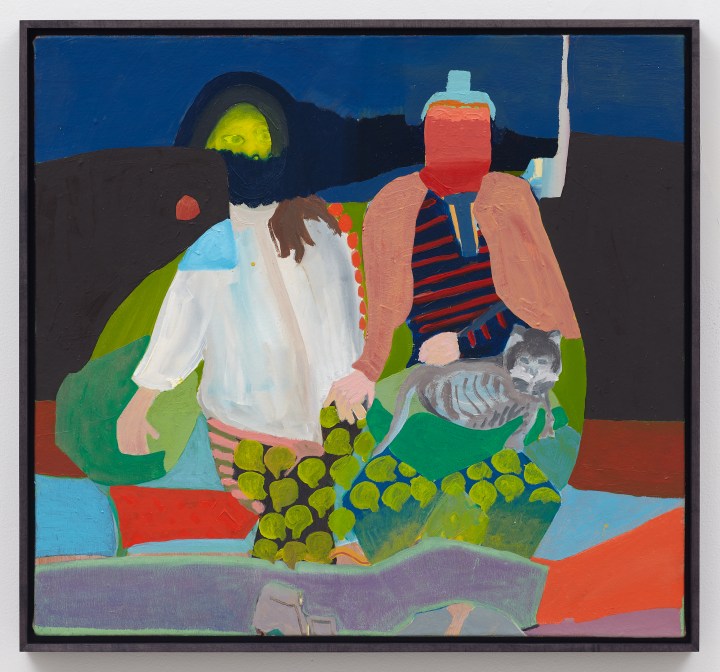June 15, 2019
Download as PDF
View on Hyperallergic

Marley Freeman, Ampersand (2018), oil on canvas, 22 1⁄8 × 23 15⁄16 inches (unframed), 22 5⁄8 × 24 7⁄16 inches (framed) (all images courtesy of Karma
Freeman transmutes a recollection into a color-based relationship between abstract forms.
Marley Freeman has covered the walls of Karma Gallery with over 20 small paintings, all acrylics and oils. She has also filled a corner of the floor with ceramic blocks, and brought her painted books into Karma’s bookshop around the corner. Her current exhibition, Park Closes at Midnight, provides a wonderful opportunity to see this forceful painter in three different modalities.
Freeman prepares a gesso ground that varies between white and off-white, on which she unleashes her imagination. Her task, as she sees it, is to get a particular form or color configuration onto the canvas quickly. We see this in her explanation in the press release of the show’s title:
Posted all over the park are signs that read “PARK CLOSES AT MIDNIGHT.” The term signifies ending. The death of a day. The park closes but it will again re-open.
The park is her canvas, the defined space where she lets her liberated imagination express itself. As she further explains, “It [painting] only happens when a time schedule collapses into the studio. That time is non-time. Hours don’t pass. Painting is done when it’s done.”
While she is predominantly an abstract painter, several canvases on view are decidedly representational. “Ampersand” (2018) looks like a family portrait, portraying a couple with a big cat on the female figure’s lap. Recalling a souvenir snapshot or a familiar cliché, the image is also a memory Freeman translates into configurations of colors and loose geometric forms. Despite the figures’ static poses, the artist infuses them with a sense of dynamic energy; the human shapes seem as if they could metamorphose into the swirling colors in a kaleidoscope.
Reconfigured memory is central to “See Past” (2019) as well. Another portrait, it depicts a person sitting in a chair, staring at an artist or photographer. Both portraits suggest the idea of parody in the sense that they take a hackneyed genre and make it new. Freeman’s intention is not to mock the model but to reinvigorate it with her individual aesthetic. The punning title of the latter painting points to memory, in terms of both seeing the past and seeing past memory by transmuting a recollection into a color-based relationship between abstract forms.
The title of “The Rear View” (2018) may allude to the compressed reflection we see looking into an automobile’s rearview mirror, but the abstract composition evokes a still life as Freeman again plays shapes against colors. Similarly, in “Old Stone” (2017-19) the interaction between shapes and pigments renders a kind of transmuted landscape, with a foreground, horizon line, and sky.
Freeman’s experiment with ceramics, Blocks (2015-19), represents yet another facet of her transmutation of memory. The four-year gestation of this mass of glazed ceramic cubes might seem to contradict her reflection on her work process — the “park-closes-at-midnight” time-frame for working — but the sculpture is a multiplicity, rather than a single unit, with each element being a work in itself. The ceramic blocks, poured onto the floor, reference childhood play, another nod to memory, this one incorporating the collective audience.
Freeman’s painted books, arrayed in a vitrine in the Karma bookstore, likewise evoke child’s play — here a child’s inclination to draw and scribble on his or her picture books. For example, she turns a volume of “The World’s Masters” art-book series, this one dedicated to El Greco, into Nature of the Difficulties. The book is no longer about El Greco but about Freeman’s spectacular experiments with color and artful modifications. The book, like the park and the canvas, becomes the space where her dazzling imagination goes to work. The viewer must go through the books to find the painted pages. All of the works on display require the viewer to absorb the immediate relationships between form and color and to think beyond them, projecting the images into memory. It is labor well worth the effort.



